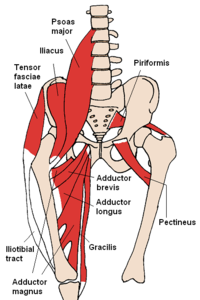Anatomy/Muscles

Muscles are comprised of fascicles, which are bundles of muscle fibers. Perimysium, a layer of connective tissue, surrounds each fascicle, and holds it together. Endomysium surrounds each muscle fiber, and epimysium surrounds the muscle itself.
Penetrating the muscle, are arteries, veins, and nerve fibers.
Skeletal muscle
[edit | edit source]The study of anatomy focuses primarily on skeletal muscles, muscles that are under voluntary nervous control. The five primary functions of skeletal muscle are maintaining body temperature, regulation of material entering or leaving the body, supporting soft tissue, aiding in the maintenance of posture, and aid in movement. There are three types of skeletal muscle fibers - fast, slow and intermediate skeletal muscle fibers. Fast fibers are powerful and can remain contracted for only about 0.01 seconds. These contractions generate more force than other fibers and use a significant amount of ATP. These fibers are also known as white fibers (associated with white meat). Weight training increases the size of fast fibers. Slow fibers, also known as red fibers (associated with red meat), react slowly to stimuli but can remain contracted for a long time. Slow fibers have a larger capillary network, aiding in the oxygenation of these fibers so that they can remain contracted for longer periods. Intermediate fibers are just that, fibers with properties in the spectrum between fast and slow fibers. Many fast fibers are slowly converted to intermediate fibers in endurance athletes, in relation to the extensiveness of their training.
Types of muscle
[edit | edit source]There are three types of muscle:
- Cardiac: Muscle that are found only in the heart. They are specialised and autonomous, with intercalated discs between each cell. The nervous system has the ability to effect changes globally. [1]
- Smooth or visceral: Smooth or visceral muscels are not under voluntary nervous control. These muscles are found in blood vessels, the digestive system, etc. Smooth muscles are responsible for peristalsis, the slow movement of food along the gastrointestinal tract towards the anus.
Origin and Insertion
[edit | edit source]Muscles are usually partly described by their origin at one end and insertion at the other. These are points of muscle attachment to bones: the origin being the point that moves least under contraction and the insertion being the end that moves most. The origin is usually more proximal and the insertion more distal. Also, the connection at the origin is typically to a stronger/thicker bone. If a muscle arises from more than one place (as in the biceps or triceps), we say that it has two (or possibly more) heads.
